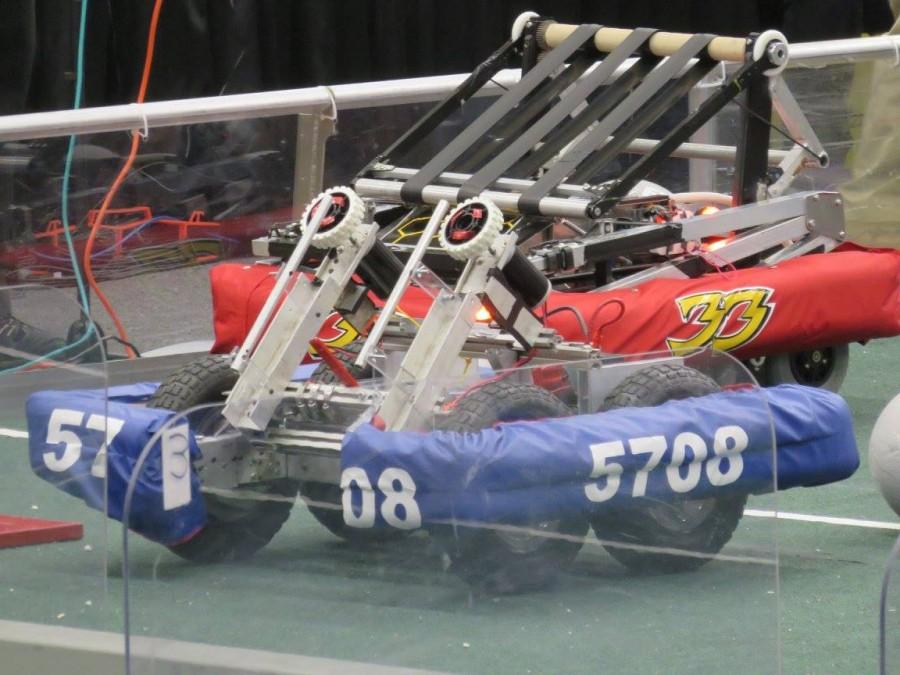Zebrotics Forge Ahead
Zebrotics robot (front) at Waterford, courtesy of Zebrotics. This relatively new team showed improved results at tournaments this year.
Community High School’s robotics team 5708, “Zebrotics,” completed its second FIRST Robotics, which is the organization that manages the robotics teams and competitions during competition season. They surpassed last year’s rankings despite encountering multiple issues including overheating motors and tricky programing. The team competed in two regional tournaments: Waterford, MI and Livonia, MI. Their robot this year was named Achilles. Achilles earned its name “because it was very strong in general, but it always had one thing that was messing up,” said CHS junior Sean Tichenor, program manager and vice-president of the Zebrotics.
At their first competition of the year in Waterford, the Zebrotics placed 30th out of 40. The ranking system is based on wins, as well as achievements within each match. In each match, six teams 一 three per an alliance 一 compete by scoring goals and crossing obstacles. The team with the most points by the end of the match wins. Last year they placed 31st at their first competition in Livonia. During this year’s competition, their main driving motors started to overheat.
“[We would] get snow from outside and put it on the motors,” said Neil Beveridge, engineering lead of the Zebrotics. “It wasn’t the best method, but for the time it was the best we could do.” The team had resolved this by the second competition by using cooling fans to cycle in cool air.
“Some of the torque calculations we did weren’t completely correct, so we didn’t have enough torque to drive our huge wheels,” Tichenor said. “Over the week we got some cooling fins and fans, which helped it a lot.”
Their second competition had fewer issues, as proven by their end ranking of 17th, which is a surge from last year’s rank of 35th.
One of the few issues during the second competition was getting the robot to go the correct distance at the start of the match in autonomous mode, where the robot is preprogrammed and runs without being controlled by a person. During this time, goals and other action earn more points. Twice the robot slammed into the wall that separates the field from where the opposing teams control their robots. “We really scared them, and their stuff went flying,” said Christia West, head mentor of the Zebrotics team. “Autonomous programming is really difficult because there were so many different obstacles … they weren’t easy to measure.”
Challenges the team faced during robot construction included getting the chassis just right. “It had to be aligned really perfectly,” Beveridge said. “It took us a couple 12-hour work sessions to get the chassis built.”
Not every part of the competition was quite as serious, as the team played a few games of ultimate frisbee with another set of zebras: Team 313, The Bionic Zebras from Wayne. “We didn’t win the competition, but we got some wins on the frisbee field,” Beveridge said.
One aspect of doing well at competition that is easy to overlook is having a robot that can work with other robots to win.
“I think the thing we did best this year was doing something that helped other teams,” Beveridge said. “Last year, we were able to perform the task that we set out to accomplish, but we realized that it didn’t really help others that much.”
One of the strategies the team used to gain points was the use of a terrain-friendly design to get over obstacles, which racked up the team points. “We had 13-inch wheels, so we just kind of plowed over all of them,” Tichenor said. The obstacles involved in this game included a 4-⅝” “Rock wall”, a series of staggered metal boxes, creating rough terrain and a few others.
The other focus of the robot’s design was to shoot goals. “We were pretty consistent once we got everything down shooting in the low goal,” West said. “Once we got all of the bugs worked out we were very consistent at what we did.”
“I think that our team dynamic is really good because it’s a small team and a new team, so we all get to do a lot,” Tichenor said. “We are all really dedicated to it because we spent a lot of time on robotics.”










